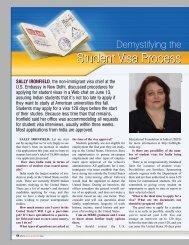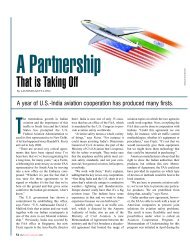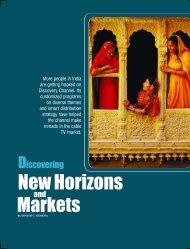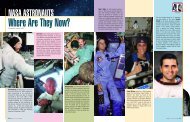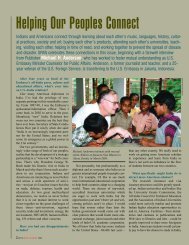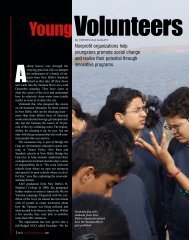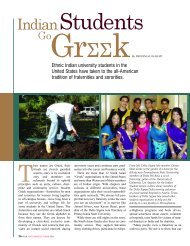Designing India: Vision 2020, SPAN March/April 2008
Designing India: Vision 2020, SPAN March/April 2008
Designing India: Vision 2020, SPAN March/April 2008
You also want an ePaper? Increase the reach of your titles
YUMPU automatically turns print PDFs into web optimized ePapers that Google loves.
management, problem solving and teamwork,<br />
the competition gave students an<br />
introduction to civil, electrical, chemical<br />
and mechanical engineering.<br />
Scott T. Lofgren, global director of<br />
Bentley Empowered Careers Network,<br />
which is part of Bentley Systems Inc.,<br />
says: “Future Cities <strong>India</strong> <strong>2020</strong> is a tribute<br />
to all those who have developed innovative<br />
design solutions to help address<br />
<strong>India</strong>’s real-world infrastructure needs.”<br />
Though he is not sure if the students’<br />
ideas will be used by the administration,<br />
the competition has “definitely stirred an<br />
interest in infrastructure engineering.”<br />
Ayush Srivastav of DAV Public School<br />
in Gurgaon, Haryana, says he learned soldering<br />
and making electrical connections,<br />
things he had only read about. “There<br />
were times we burnt our hands handling<br />
the hot charcoal to make the miniature<br />
roads in our model. The experience will<br />
remain with me as it gave me a confidence<br />
of attempting the unknown,” Srivastav<br />
says of the efforts of his team, which came<br />
second.<br />
“We were trained in using state-of-theart<br />
modeling software like MXROAD<br />
and MicroStation V8XM by Bentley. We<br />
learnt about 3D analysis and new innovations<br />
in architecture,” says Apeejay’s<br />
Ajaypat Jain, who is 16 years old. “We<br />
even devised a new technology like...the<br />
robot mechanized navigation system for a<br />
very futuristic building system called the<br />
Simulation Center.”<br />
Says 16-year-old Akansha Sharma<br />
from Apeejay School in Faridabad,<br />
Haryana, “The long hours of research and<br />
work that has gone into this project have<br />
sparked a desire in me to carry this on. In<br />
fact, we often discuss that we should form<br />
an architecture firm when we grow up.”<br />
Sharma’s teacher, Mamta Arora, says<br />
the students sometimes put in 11-hour sessions<br />
designing and redesigning their presentations.<br />
Each team was guided by a<br />
teacher, often a specialist in computers or<br />
science, and an engineer who volunteered.<br />
Despite the disparity of design, one idea<br />
cut across all groups: making the project<br />
environment friendly. From solar-powered<br />
vehicles, solar panels on rooftops and<br />
rainwater harvesting to using bricks made<br />
from fly ash, and no-vehicle zones, the<br />
students wanted their future cities to be<br />
pollution-free.<br />
“Global warming is the issue of the day<br />
and I’m sure by <strong>2020</strong>, we will be in the<br />
middle of a severe climate crisis. We<br />
don’t want to leave a large carbon footprint<br />
for our kids. And anyway, planning<br />
ahead never hurt anyone. It’s better to<br />
think now than repent later,” says<br />
Left: The team from Apeejay School in Noida explains its design concept to an audience<br />
member. From left are team mentor and biology teacher Pinky Mathur, students Ajaypat<br />
Jain, E.R. Subramanian, Gagan Anand and Anshul Singh.<br />
Below: Students Zoya Khan, Pourav Banerjee and Abhinav Mittal of New Delhi’s Apeejay<br />
School interact with Scott T. Lofgren (center), global director of Bentley Empowered<br />
Careers Network and Jugal Makwana of Bentley Systems in <strong>India</strong>.<br />
Graphic by HEMANT BHATNAGAR Photographs © Creative/Getty Images<br />
Future Dilemma:<br />
Too Many People,<br />
Too Little Space<br />
From 13 percent in 1900, the global proportion<br />
of urban dwellers increased to 49<br />
percent in 2005. According to projections<br />
by the United Nations Populations Division, 60<br />
percent of the world’s population, or about 4.9<br />
billion people, are expected to live in cities by<br />
2030.<br />
By 2015, Mumbai will be the world’s second<br />
most populous city, with an estimated population<br />
of 20.9 million. New Delhi and Kolkata will<br />
remain among the most populous cities, and it<br />
is also anticipated that Mumbai and New Delhi<br />
will grow faster than any other city in the world.<br />
Population scientist Joel E. Cohen, author of<br />
How Many People Can the Earth Support?, said<br />
at a panel discussion organized by the<br />
American Academy of Arts and Sciences:<br />
“From now to 2030, the world will need to build<br />
the equivalent of a city of one million in developing<br />
countries every five days,” reported a<br />
New York Times blog.<br />
The question is, how long can the earth sustain<br />
and support this everincreasing<br />
population,<br />
which is projected to<br />
increase from 6 billion<br />
in 1999 to 9 billion<br />
by 2042.<br />
Akansha Sharma, whose favorite pastime<br />
is bird-watching.<br />
Spending what was the busiest winter<br />
vacation of their lives, the students agreed<br />
they had had an incomparable experience.<br />
“The project was challenging and we<br />
did get stuck at times but our teachers and<br />
our team spirit always rescued us,” says<br />
Ajaypat Jain. “More than the prize, it is the<br />
experience that will remain with us.”<br />
Please share your views on this article.<br />
Write to editorspan@state.gov<br />
<strong>SPAN</strong> MARCH/APRIL <strong>2008</strong> 49<br />
URBAN DEVELOPMENT




